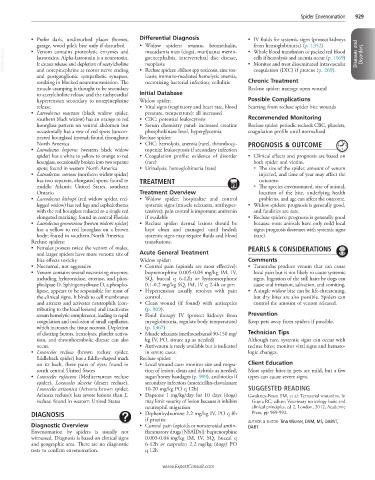Page 1851 - Cote clinical veterinary advisor dogs and cats 4th
P. 1851
Spider Envenomation 929
• Prefer dark, undisturbed places (homes, Differential Diagnosis • IV fluids for systemic signs (protect kidneys
garage, wood pile); bite only if disturbed • Widow spiders: tetanus, bromethalin, • Whole blood transfusion or packed red blood
from hemoglobinuria) (p. 1352)
VetBooks.ir latrotoxins. Alpha-latrotoxin is a neurotoxin. goencephalitis, intervertebral disc disease, • Monitor and treat disseminated intravascular Diseases and Disorders
macadamia nuts (dogs), marijuana; menin-
• Venom contains proteolytic enzymes and
cells if hemolysis and anemia occur (p. 1169)
neoplasia
It causes release and depletion of acetylcholine
and norepinephrine at motor nerve ending
and postganglionic sympathetic synapses, • Recluse spiders: Allium spp toxicosis, zinc tox- coagulation (DIC) if present (p. 269).
icosis; immune-mediated hemolytic anemia,
resulting in blocked neurotransmission. The necrotizing bacterial infection, cellulitis Chronic Treatment
muscle cramping is thought to be secondary Recluse spider: manage open wound
to acetylcholine release and the tachycardia/ Initial Database
hypertension secondary to norepinephrine Widow spider: Possible Complications
release. • Vital signs (respiratory and heart rate, blood Scarring from recluse spider bite wounds
• Latrodectus mactans (black widow spider, pressure, temperature): all increased
southern black widow) has an orange to red • CBC: potential leukocytosis Recommended Monitoring
hourglass pattern on ventral abdomen but • Serum chemistry panel: increased creatine Recluse spider: periodic recheck CBC, platelets,
occasionally has a row of red spots (uncon- phosphokinase level, hyperglycemia coagulation profile until normalized
nected hourglass) instead; found throughout Recluse spider:
North America • CBC: hemolysis, anemia (rare), thrombocy- PROGNOSIS & OUTCOME
• Latrodectus hesperus (western black widow topenia; leukocytosis if secondary infection
spider) has a white to yellow to orange to red • Coagulation profile: evidence of disorder • Clinical effects and prognosis are based on
hourglass, occasionally broken into two separate (rare) both spider and victim.
spots; found in western North America • Urinalysis: hemoglobinuria (rare) ○ The size of the spider, amount of venom
• Latrodectus. various (northern widow spider) injected, and time of year may affect the
has two separate, elongated spots; found in TREATMENT outcome.
middle Atlantic United States, southern ○ The species envenomated, size of animal,
Ontario Treatment Overview location of the bite, underlying health
• Latrodectus bishopi (red widow spider, red- • Widow spider: hospitalize and control problems, and age can affect the outcome.
legged widow) has red legs and cephalothorax systemic signs (muscle relaxants, antihyper- • Widow spiders: prognosis is generally good,
with the red hourglass reduced to a single red tensives); pain control is important; antivenin and fatalities are rare.
elongated marking; found in central Florida if available • Recluse spiders: prognosis is generally good
• Latrodectus geometricus (brown widow spider) • Recluse spider: dermal lesions should be because most animals have only mild local
has a yellow to red hourglass on a brown kept clean and managed until healed; signs; prognosis decreases with systemic signs
body; found in southern North America systemic signs may require fluids and blood (rare).
Recluse spiders: transfusions.
• Females possess twice the venom of males, PEARLS & CONSIDERATIONS
and larger spiders have more venom; site of Acute General Treatment
bite effects toxicity Widow spider: Comments
• Nocturnal, not aggressive • Control pain (opioids are most effective): • Tarantulas produce venom that can cause
• Venom contains several necrotizing enzymes, buprenorphine 0.005-0.04 mg/kg IM, IV, local pain but is not likely to cause systemic
including hyluronidase, esterase, and phos- SQ, buccal q 6-12h or hydromorphone signs. Ingestion of the still hairs by dogs can
pholipase D. Sphingomyelinase D, a phospho- 0.1-0.2 mg/kg SQ, IM, IV q 2-4h or prn cause oral irritation, salivation, and vomiting.
lipase, appears to be responsible for most of • Hypertension usually resolves with pain • A single widow bite can be life-threatening,
the clinical signs. It binds to cell membranes control. but dry bites are also possible. Spiders can
and attracts and activates neutrophils (con- • Clean wound (if found) with antiseptics control the amount of venom released.
tributing to the local lesions) and inactivates (p. 909).
serum hemolytic complement, leading to rapid • Fluid therapy IV (protect kidneys from Prevention
coagulation and occlusion of small capillaries, myoglobinuria, regulate body temperature) Keep pets away from spiders if possible.
which increases the tissue necrosis. Depletion (p. 1367)
of clotting factors, hemolysis, platelet activa- • Muscle relaxants (methocarbamol 50-150 mg/ Technician Tips
tion, and thromboembolic disease can also kg IV, PO, titrate up as needed) Although rare, systemic signs can occur with
occur. • Antivenom is rarely available but is indicated recluse bites; monitor vital signs and hemato-
• Loxosceles reclusa (brown recluse spider, in severe cases. logic changes.
fiddleback spider) has a fiddle-shaped mark Recluse spider:
on its back, three pairs of eyes; found in • Local wound care: monitor size and migra- Client Education
south central United States tion of lesion; clean and debride as needed, Most spider bites in pets are mild, but a few
• Loxosceles rufescens (Mediterranean recluse sugar/honey bandages (p. 909), antibiotics if types can cause severe signs.
spider), Loxosceles deserta (desert recluse), secondary infection (amoxicillin-clavulanate
Loxosceles arizonica (Arizona brown spider, 10-20 mg/kg PO q 12h) SUGGESTED READING
Arizona recluse): less severe lesions than L. • Dapsone 1 mg/kg/day for 10 days (dogs) Gwaltney-Brant SM, et al: Terrestrial zootoxins. In
reclusa; found in western United States may limit severity of lesion because it inhibits Gupta RC, editor: Veterinary toxicology basic and
neutrophil migration clinical principles, ed 2, London, 2012, Academic
DIAGNOSIS • Diphenhydramine 2.2 mg/kg IV, PO q 8h Press, pp 969-992.
if pruritic AUTHOR & EDITOR: Tina Wismer, DVM, MS, DABVT,
Diagnostic Overview • Control pain (opioids or nonsteroidal antiin- DABT
Envenomation by spiders is usually not flammatory drugs [NSAIDs]): buprenorphine
witnessed. Diagnosis is based on clinical signs 0.005-0.04 mg/kg IM, IV, SQ, buccal q
and geographic area. There are no diagnostic 6-12h or carprofen 2.2 mg/kg (dogs) PO
tests to confirm envenomation. q 12h
www.ExpertConsult.com

